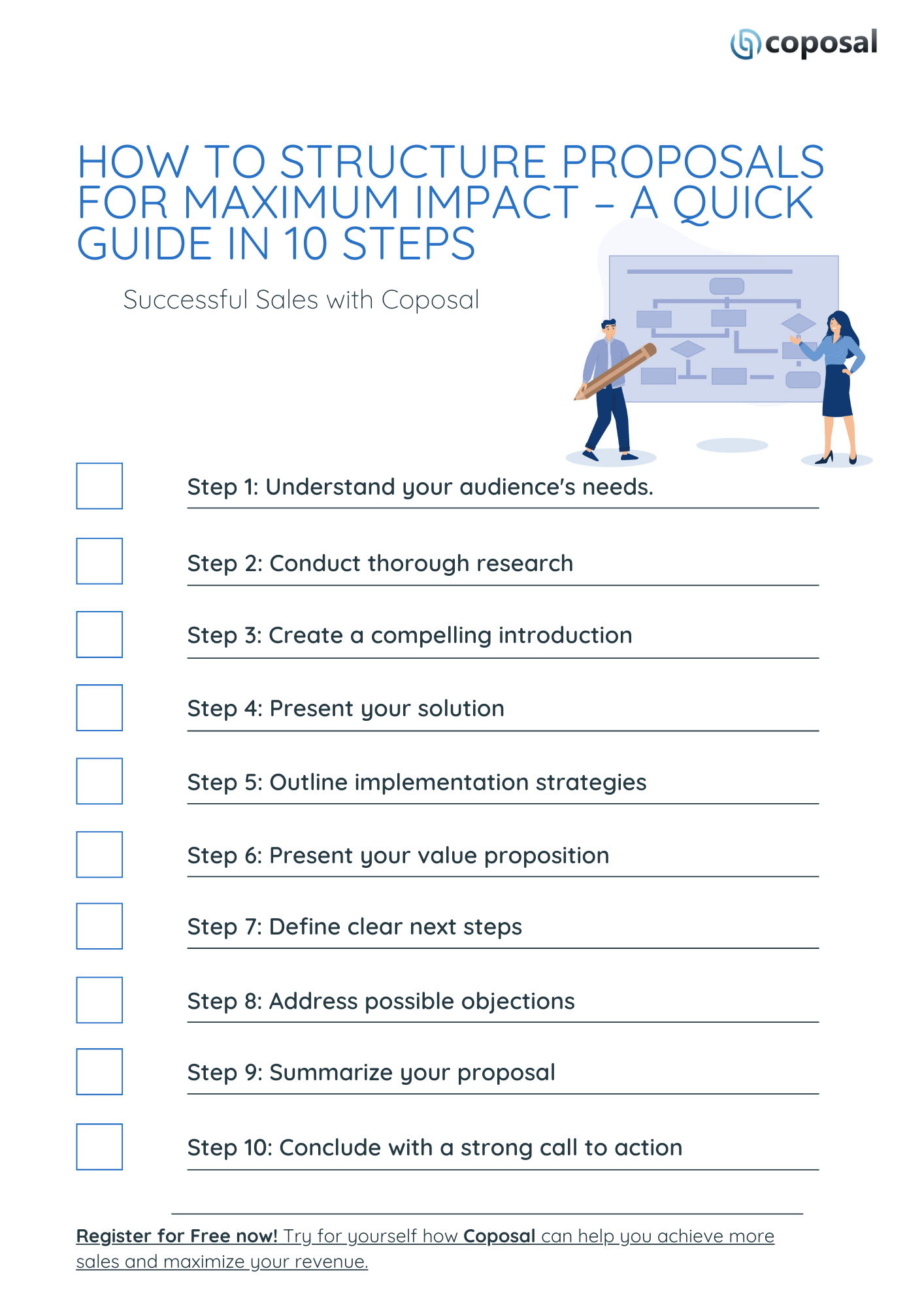 In today's competitive business environment, crafting proposals that stand out and captivate potential customers is critical.
In today's competitive business environment, crafting proposals that stand out and captivate potential customers is critical.
This quick guide outlines 10 essential steps to structure your offerings effectively, achieve maximum impact, and increase your chances of success.
Table of Contents
- Understand the importance of structured proposals
- Understand your audience's needs.
- Conduct thorough research
- Create a compelling introduction
- Present your solution
- Outline implementation strategies
- Present your value proposition
- Define clear next steps
- Address possible objections
- Summarize your proposal
- Conclude with a strong call to action
Understand the importance of structured proposals
Before diving into the intricacies of proposal writing, it's important to understand why structure is important.
A well-structured offer not only conveys professionalism, but also shows a clear understanding of the customer's needs.
It improves readability, makes it easier for decision makers to navigate your offer, and ultimately increases your chances of closing.
Step 1: Understand your audience's needs.
 Before you dive into the process of writing a proposal, take the time to figure out who your target audience is.
Before you dive into the process of writing a proposal, take the time to figure out who your target audience is.
What are their vulnerabilities, priorities and goals? This will give you valuable insights and insights into what specific components your offer needs to include.
Adjust the structure of your proposal accordingly to address their specific needs and concerns.
Step 2: Conduct thorough research
Data, statistics and other evidence will help you support your proposal.
Conduct thorough research to back up your claims and demonstrate credibility. This not only strengthens your offer but also creates trust with your audience.
Step 3: Create a compelling introduction
 Capture your audience's attention right from the start with a compelling introduction.
Capture your audience's attention right from the start with a compelling introduction.
Highlight the problem or opportunity at hand and explain why it is important to address it. Engage your readers and arouse their interest.
Step 4: Present your solution
Present your solution clearly and concisely. Break down the steps you will take to address the problem or capitalize on the opportunity.
Use bullet points or numbered lists to make your offer easy to understand and concise.
Step 5: Outline implementation strategies
An effective proposal not only identifies solutions, but also describes how they will be implemented.
Provide a detailed action plan, including timelines, milestones and responsibilities. Break the implementation process down into manageable steps, demonstrating your thoroughness and attention to detail.
Step 6: Present your value proposition
 Highlight the unique value proposition of your offering.
Highlight the unique value proposition of your offering.
What makes your solution different from others?
Whether cost-effectiveness, innovation or efficiency – emphasize why your offer is the best choice.
Step 7: Define clear next steps
Guide your audience on what to do next. Whether it's scheduling a follow-up meeting, providing additional information, or making a decision, outline clear next steps to keep the momentum going.
Step 8: Address possible objections
 Anticipate and address possible objections or concerns from your audience.
Anticipate and address possible objections or concerns from your audience.
Acknowledge challenges in advance and offer solutions or remedial strategies to address any doubts or concerns.
Step 9: Summarize your proposal
Finally, emphasize the value proposition of your proposal and the return on investment (ROI) it offers.
Clearly articulate the benefits the customer can expect from implementing your solution, be it increased efficiency, cost savings, or revenue growth. Use data and case studies to support your claims and demonstrate tangible results.
By quantifying the benefits of your proposal, you make it easier for the customer to justify their investment.
Step 10: Conclude with a strong call to action
End your offer with a compelling call-to-action.
Encourage your audience to take the action you want, whether that's signing a contract, making a purchase, or implementing your offer. Make them feel inspired and motivated to take action.
Summary
Creating effective offerings requires a strategic approach and attention to detail.
By internalizing the steps described here, you can structure your proposal effectively and increase your chances of success.
Remember to tailor your offerings to each customer's specific needs, emphasize the value of your solution, and remain proactive throughout the decision-making process.
With practice and persistence, you can master the art of proposal writing and achieve your business goals.
 Reading tip: If our article helped you and you would like to find out more about the structure and content of proposals, you can find further information here: "Tips for writing successful proposals"
Reading tip: If our article helped you and you would like to find out more about the structure and content of proposals, you can find further information here: "Tips for writing successful proposals"
Frequently asked questions on the topic of Structuring proposals
How can I stand out from the competition with my proposals?
Crafting a unique value proposition tailored to the customer's specific needs is key to making your offerings stand out from the crowd.
Focus on addressing their pain points and demonstrating the tangible benefits of your solution.
How can I ensure that my offer is visually appealing?
Incorporating visual elements such as graphics, charts, and images can improve the readability and visual appeal of your offer.
However, ensure that these elements complement the content and serve to clarify or reinforce important points rather than detract from the overall message.
Should I include a call to action in my proposal?
Yes, including a clear and compelling call to action encourages the reader to take the next steps, whether that's scheduling a follow-up meeting, signing a contract, or requesting additional information.
Make sure your call to action is specific, actionable, and aligned with the goals of your proposal.
How can I make my proposals more convincing?
To make your proposals more compelling, focus on highlighting the unique benefits and benefits of your solution, providing concrete examples and case studies to support your claims, and using persuasive language and storytelling techniques to engage the reader on an emotional level.